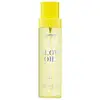What's inside
What's inside
 Key Ingredients
Key Ingredients

No key ingredients
 Benefits
Benefits

 Concerns
Concerns

 Ingredients Side-by-side
Ingredients Side-by-side

Water
Skin ConditioningGlycerin
HumectantCetrimonium Chloride
AntimicrobialPersea Gratissima Oil
Skin ConditioningAloe Barbadensis Leaf Juice
Skin ConditioningSalvia Officinalis Leaf Extract
CleansingOcimum Basilicum Leaf Extract
Skin ConditioningPrunus Armeniaca Kernel Oil
MaskingSelaginella Lepidophylla Extract
EmollientRosmarinus Officinalis Leaf Extract
AntimicrobialCarapa Guaianensis Seed Oil
Skin ConditioningOlea Europaea Fruit Oil
MaskingCocos Nucifera Oil
MaskingHelianthus Annuus Seed Oil
EmollientPiper Nigrum Seed Extract
RefreshingSqualane
EmollientPhenoxyethanol
PreservativeHydroxyethyl Acrylate/Sodium Acryloyldimethyl Taurate Copolymer
Emulsion StabilisingC20-22 Alkyl Phosphate
EmulsifyingAminomethyl Propanol
BufferingCitric Acid
BufferingDisodium EDTA
Ethylhexylglycerin
Skin ConditioningPolysorbate 60
EmulsifyingPotassium Sorbate
PreservativeSodium Benzoate
MaskingC20-22 Alcohols
Emulsion StabilisingParfum
MaskingLimonene
PerfumingLinalool
PerfumingWater, Glycerin, Cetrimonium Chloride, Persea Gratissima Oil, Aloe Barbadensis Leaf Juice, Salvia Officinalis Leaf Extract, Ocimum Basilicum Leaf Extract, Prunus Armeniaca Kernel Oil, Selaginella Lepidophylla Extract, Rosmarinus Officinalis Leaf Extract, Carapa Guaianensis Seed Oil, Olea Europaea Fruit Oil, Cocos Nucifera Oil, Helianthus Annuus Seed Oil, Piper Nigrum Seed Extract, Squalane, Phenoxyethanol, Hydroxyethyl Acrylate/Sodium Acryloyldimethyl Taurate Copolymer, C20-22 Alkyl Phosphate, Aminomethyl Propanol, Citric Acid, Disodium EDTA, Ethylhexylglycerin, Polysorbate 60, Potassium Sorbate, Sodium Benzoate, C20-22 Alcohols, Parfum, Limonene, Linalool
Butyl Methoxydibenzoylmethane 3%
UV AbsorberHomosalate 10%
Skin ConditioningEthylhexyl Salicylate 5%
UV AbsorberOctocrylene 10%
UV AbsorberCaprylic/Capric Triglyceride
MaskingAlcohol
AntimicrobialOctyldodecanol
EmollientC12-15 Alkyl Benzoate
AntimicrobialPolyester-8
Skin ConditioningPolyamide-3
Lauryl Lactate
EmollientIsodecyl Neopentanoate
EmollientDiisopropyl Sebacate
EmollientDiethylhexyl Syringylidenemalonate
Skin ProtectingTocopherol
AntioxidantGlycine Soja Oil
EmollientVitis Vinifera Seed Oil
EmollientRaphanus Sativus Seed Oil
EmollientLimnanthes Alba Seed Oil
Skin ConditioningHelianthus Annuus Seed Oil
EmollientCocos Nucifera Oil
MaskingButyrospermum Parkii Butter
Skin ConditioningArgania Spinosa Kernel Oil
EmollientPentaerythrityl Tetra-Di-T-Butyl Hydroxyhydrocinnamate
AntioxidantAlaria Esculenta Extract
Skin ProtectingT-Butyl Alcohol
PerfumingCucumis Sativus Fruit Extract
EmollientDenatonium Benzoate
MaskingCitric Acid
BufferingButyl Methoxydibenzoylmethane 3%, Homosalate 10%, Ethylhexyl Salicylate 5%, Octocrylene 10%, Caprylic/Capric Triglyceride, Alcohol, Octyldodecanol, C12-15 Alkyl Benzoate, Polyester-8, Polyamide-3, Lauryl Lactate, Isodecyl Neopentanoate, Diisopropyl Sebacate, Diethylhexyl Syringylidenemalonate, Tocopherol, Glycine Soja Oil, Vitis Vinifera Seed Oil, Raphanus Sativus Seed Oil, Limnanthes Alba Seed Oil, Helianthus Annuus Seed Oil, Cocos Nucifera Oil, Butyrospermum Parkii Butter, Argania Spinosa Kernel Oil, Pentaerythrityl Tetra-Di-T-Butyl Hydroxyhydrocinnamate, Alaria Esculenta Extract, T-Butyl Alcohol, Cucumis Sativus Fruit Extract, Denatonium Benzoate, Citric Acid
 Reviews
Reviews

Ingredients Explained
These ingredients are found in both products.
Ingredients higher up in an ingredient list are typically present in a larger amount.
Citric Acid is an alpha hydroxy acid (AHA) naturally found in citrus fruits like oranges, lemons, and limes.
Like other AHAs, citric acid can exfoliate skin by breaking down the bonds that hold dead skin cells together. This helps reveal smoother and brighter skin underneath.
However, this exfoliating effect only happens at high concentrations (20%) which can be hard to find in cosmetic products.
Due to this, citric acid is usually included in small amounts as a pH adjuster. This helps keep products slightly more acidic and compatible with skin's natural pH.
In skincare formulas, citric acid can:
While it can provide some skin benefits, research shows lactic acid and glycolic acid are generally more effective and less irritating exfoliants.
Most citric acid used in skincare today is made by fermenting sugars (usually from molasses). This synthetic version is identical to the natural citrus form but easier to stabilize and use in formulations.
Read more about some other popular AHA's here:
Learn more about Citric AcidCocos Nucifera Oil is obtained from the kernels of the coconut fruit. In other words, this is coconut oil.
Coconut Oil is rich in fatty acids with lauric acid making up the majority of these. It also contains linoleic acid. Due to this high fatty acid content, coconut oil helps trap moisture and soften skin.
Despite being antibacterial, coconut oil may not be great for acne-prone skin. It is comedogenic and may clog pores. This ingredient may not be safe for malassezia or fungal acne.
Note: Coconut Oil should not replace your sunscreen for UV protection. Studies show it only blocks about 20% of UV.
This oil is non-volatile and has a light scent.
The term 'fragrance' is not regulated in many countries. In many cases, it is up to the brand to define this term. For instance, many brands choose to label themselves as "fragrance-free" because they are not using synthetic fragrances. However, their products may still contain ingredients such as essential oils that are considered a fragrance.
Learn more about Cocos Nucifera OilHelianthus Annuus Seed Oil is the oil derived from the seeds of a Sunflower. Sunflower seed oil is non-fragrant. It is an emollient, meaning it helps to soften the skin.
Sunflower seed oil contains many fatty acids. The fatty acids found in sunflower seeds include (from highest amount to least): linoleic acid, myristic acid, palmitic acid, stearic acid, arachidic acid, oleic acid, and linolenic acid.
These fatty acids help the skin create ceramides. Ceramides play a role in repairing the skin barrier.
Helianthus Annuus Seed Oil helps moisturize the skin. This in turn helps the skin look more rejuvenated and smoother.
Sunflowers are rich in vitamin E.
Historians believe Indigenous cultures of North America domesticated sunflowers before corn. Thus they relied on sunflower oil for a variety of uses. One such use is moisturizing skin and hair.
Sunflower seed oil may not be fungal acne safe. We recommend speaking with a professional if you have any concerns.
Learn more about Helianthus Annuus Seed Oil